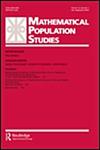Nicholson模型中产卵期的缩短促进了蝇类种群的灭绝
IF 1.3
3区 社会学
Q3 DEMOGRAPHY
引用次数: 3
摘要
摘要:果蝇利用开放性伤口或粪便或尿液在羊毛中积聚来产卵。出现的幼虫会对宿主绵羊造成损伤,从而导致死亡。它们分布在澳大利亚、新西兰和英国。尼科尔森的模型描述了澳大利亚飞蝇(Lucilia Cuplina)的种群动态。它包含了环境变化。这些苍蝇的灭绝取决于产卵的时间和世代之间的时间。李亚普诺夫函数是正的,具有负导数,它为平衡点的稳定性提供了条件:产卵期必须足够短,因为它越短,就越有利于物种的灭绝。零解是唯一的平衡点,与种群灭绝同义。另一种飞蝇Lucilia Sericata也攻击澳大利亚的绵羊。这两种蝇都是温血脊椎动物的体外寄生虫,尤其是家养绵羊。尽管这两个物种不同,但这两种果蝇的线粒体DNA序列相同。大概是为了避免他们之间的竞争。每个物种的产卵时间都不在一年中的同一时间:丝蚕喜欢温暖的月份,因此在夏天,而Cuprina主要活跃在秋天。在不同的月份产卵可以避免这些物种之间的竞争。这也将它们结合在一起。如果产卵延迟得足够小,就会导致这两种飞蝇种群迅速灭绝,前提是它们不能适应。本文章由计算机程序翻译,如有差异,请以英文原文为准。
Reduced oviposition period promotes blowfly population extinction in Nicholson’s model
ABSTRACT Blowflies use open wounds or the accumulation of feces or urine in wool to lay their eggs. The larvae that emerge cause lesions in the host sheep, which can lead to death. They are found in Australia, New Zealand, and the United Kingdom. Nicholson’s model describes the population dynamics of the Australian blowfly (Lucilia Cuprina). It incorporates environmental variation. The extinction of these flies depends on the time to oviposition and the time between generations. The Lyapunov function, which is positive with a negative derivative, provides the condition for the stability of the equilibrium point: the oviposition period must be sufficiently short, because the shorter it is, the more it favors the extinction of the species. The zero solution is the only equilibrium point, synonymous with the extinction of the population. Another species of blowfly, Lucilia Sericata, also attacks sheep in Australia. Both blowflies are ectoparasites of warm-blooded vertebrates, particularly domestic sheep. These two blowflies are related to share same mitochondrial DNA sequences, although the two species are distinct. Presumably to avoid competition between them. the egg-laying time of each species does not occur at the same time of year: L. Sericata prefers warmer months, thus in summer, while L. Cuprina is mainly active in autumn. Laying of eggs in different months allows avoiding competition between these species. This also binds them together. A sufficiently small egg-laying delay then leads to the rapid extinction of both blowfly populations, provided they do not adapt.
求助全文
通过发布文献求助,成功后即可免费获取论文全文。
去求助
来源期刊

Mathematical Population Studies
数学-数学跨学科应用
CiteScore
3.20
自引率
11.10%
发文量
7
审稿时长
>12 weeks
期刊介绍:
Mathematical Population Studies publishes carefully selected research papers in the mathematical and statistical study of populations. The journal is strongly interdisciplinary and invites contributions by mathematicians, demographers, (bio)statisticians, sociologists, economists, biologists, epidemiologists, actuaries, geographers, and others who are interested in the mathematical formulation of population-related questions.
The scope covers both theoretical and empirical work. Manuscripts should be sent to Manuscript central for review. The editor-in-chief has final say on the suitability for publication.
 求助内容:
求助内容: 应助结果提醒方式:
应助结果提醒方式:


